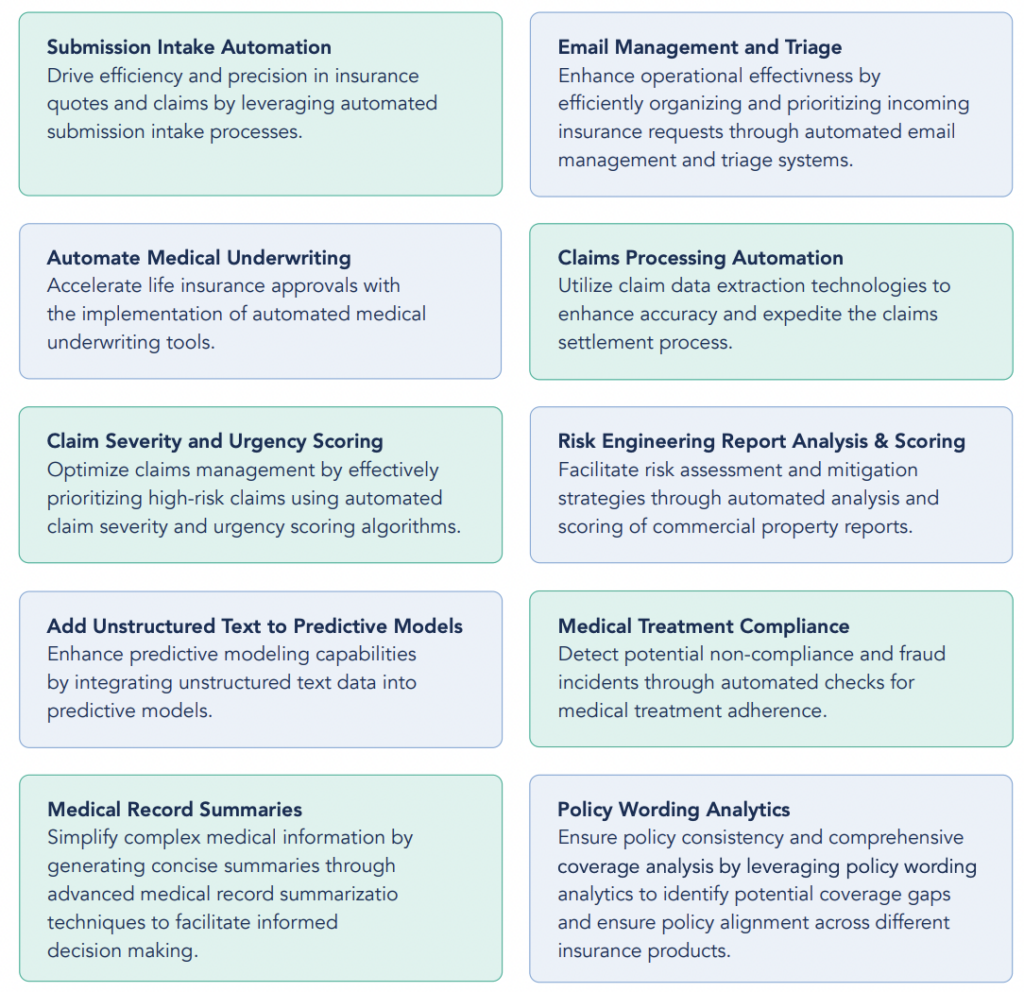
In 2024, insurers are looking for efficiency and innovation to deal with the challenges of an ever-changing, digital world. And no one wants to be left behind. Artificial Intelligence is already a powerful ally in many insurance processes, and Generative AI, with its potential to increase productivity and efficiency in certain activities, certainly has a role to play in a much larger strategy.
As a recent KPMG Pulse survey reported, “C-suite and business leaders across the United States are eager to accelerate their GenAI strategies, but recognize they must first make meaningful investments in data security, governance frameworks and workforce preparedness to enable long-term business value.”
However, successful integration demands a strategic approach. So, as companies are eager to move the needle from hype to growth driver, it’s important to take a thoughtful approach to emerging AI capabilities like Generative AI and LLMs and the areas where they are best deployed.
Setting the Strategic Framework
As companies initiate their own AI strategies, they must focus prioritize solving real problems, deploying AI responsibly and ensuring data security above all else.
Now that you understand the limitations and risks and have addressed the adoption challenges, it’s time to figure out the best use cases for experimentation, and ultimately, deployment. Rather than diving headfirst into GenAI implementation, use this framework to get started:
1. Solve a Business Problem First
Rather than adopting technology for the sake of it, identify pressing business challenges that need solving. When tackling business challenges, don’t just focus on deploying capabilities. Instead, ask yourself where language data is crucial for your business, because these are the areas where AI and GenAI specifically can add the most value.
Insurance workflows heavily rely on the meticulous handling of information. Accuracy and consistency are paramount in data capture processes, and this requires stringent measures for protecting intellectual property and personally identifiable information. Compliance with rigorous privacy, security and regulatory standards is critical for maintaining the integrity of these operations.
Here are three starting points to consider:
- Analyze existing processes to identify areas where AI can add the most value.
- Focus on use cases where you can improve efficiency and, directly or indirectly, impact customer satisfaction.
- Prioritize projects that have a clear ROI.
2. Explore Highest Value Use Cases
Three areas where Generative AI has shown to provide value is in supporting automation for repetitive tasks, enhancing the customer experience and improving risk management. Let’s look closer at the opportunities for each.
Automate Repetitive Tasks: Using AI to automate lower-value, repetitive tasks allows you to streamline operations, freeing skilled workers to focus on higher- value, more impactful activities.
- Processing for routine claims
- Claims severity and urgency categorization
- Medical records processing and summarization
Enhance the Customer Experience: GenAI-based chatbots that understand customers and respond to complex queries can help build trust and reduce the workload on human agents who can focus on higher-value customer service issues.
- Chatbots for Q&A and virtual assistants
- CSR agent knowledge bases and semantic document search
Don’t forget: Because GenAI can still behave in unpredictable ways, a human in the loop will always be necessary.
Improve Risk Management: The primary objective of risk management is to mitigate losses for insurers. However, the large amount of risk information available and limited analyst capacity often results in only a fraction of available information being reviewed. Furthermore, inconsistencies arise from subjective interpretations of non-standardized reports sourced from multiple channels, which only exacerbates the time-consuming and error-prone nature of risk exposure evaluation.
AI offers a comprehensive solution for ensuring that all of the information you manage is incorporated into risk analysis:
- Support for predictive analytics
- Identify patterns and anomalies that signal potential fraud or risk
- Drive data-driven decision making for commercial property analysis, medical underwriting and everything in between
3. Keep a Regulatory Perspective
In the insurance industry, it’s crucial to be deliberate when incorporating AI into your operations. This means making sure the chosen AI path or tool fits your business model and meets regulatory requirements. With regulators, journalists and customers closely watching, it’s important to prioritize Responsible AI, especially when using GenAI and LLMs. Keep humans involved in your approach to ensure accountability and trust in your AI efforts.
Remember:
- Balance areas where AI can provide significant value while also adhering to stringent legal and ethical standards.
- Ensure alignment with relevant data protection laws, such as GDPR in Europe, HIPPA in the US or CCPA in California.
- Stay ahead of evolving regulations and industry guidelines that prioritize transparency, fairness and explainability to prevent discriminatory practices.
Conclusion
As insurers embrace AI, they must remain agile and forward thinking. A future-proof strategy must incorporate anticipating regulatory shifts, prioritizing ethical considerations and fostering a culture of innovation and adaptability.
By adopting a strategic approach focused on addressing real business challenges, exploring high-value use cases and navigating regulatory complexities, insurers can unlock the full potential of AI technologies while driving sustainable growth and innovation.
In summary, remember these three takeaways:
- Identify Key Use Cases: Analyze existing processes to pinpoint areas where Generative AI can deliver value. Focus on projects with clear ROI potential and those that have significant impact on efficiency and customer satisfaction.
- Pilot Projects for Validation: Once potential use cases are identified, initiate pilot projects to test GenAI capabilities in real-world scenarios. Use feedback and results to refine approaches before full-scale deployment.
- Ensure Human Oversight: While GenAI offers immense potential, human oversight remains crucial. Insurers must maintain a human-in-the-loop approach to mitigate risks and ensure responsible AI use.

10 Insurance Use Cases for GenAI and LLMs from “The Ultimate Buyer’s Guide: Generative AI and LLMs in Insurance.”


